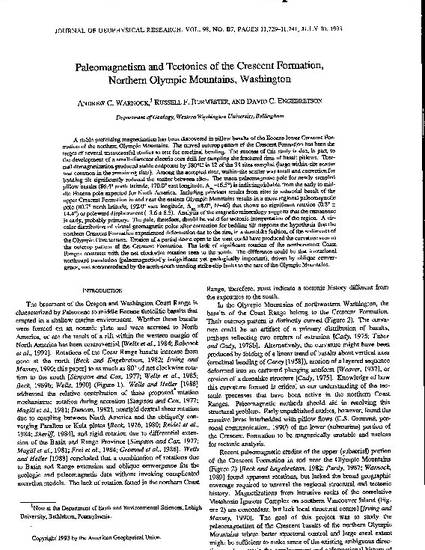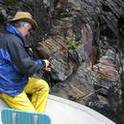
A stable prefolding magnetization has been discovered in pillow basalts of the Eocene lower Crescent Formation of the northem Olympic Mountains. The curved outcrop pattern of the Crescent Formation has been the target of several unsuccessful studies to test for oroclinal bending. The success of this study is due, in part, to the development of a small-diameter electric core drill for sampling the fractured rims of basalt pillows. Thermal demagnetization produced stable endpoints by 580°C in 12 of the 34 sites sampled (large within-site scatter was common in the remaining sites). Among the accepted sites, within-site scatter was small and correction for bedding tilt significantly reduced the scatter between sites. The mean paleomagnetic pole for newly sampled pillow basalts (86.4° north latitude, 170.0° east longitude, A95=16.5°) is indistinguishable from the early to middle Eocene pole expected for North America. Including previous results from sites in subaerial basalt of the upper Crescent Formation in and near the eastem Olympic Mountains results in a more regional paleomagnetic pole (80.7° north latitude, 192.0° east longitude, A95 =8.0°, N=46) that shows no significant rotation (0.8° ± 14.4°) or poleward displacement (-3.6 ± 8.5). Analysis of the magnetic mineralogy suggests that the remanence is early, probably primary. The pole, therefore, should be valid for tectonic interpretation of the region. A circular distribution of virtual geomagnetic poles after correction for bedding tilt supports the hypothesis that the northem Crescent Formation experienced deformation due to the rise, in a domelike fashion, of the sediments of the Olympic Core terrane. Erosion of a partial dome open to the west could have produced the curvature seen in the outcrop pattern of the Crescent Formation. The lack of significant rotation of the northernmost Coast Ranges contrasts with the net clockwise rotation seen to the south. The difference could be that irrotational northward translation (paleomagnetically insignificant yet geologically important), driven by oblique convergence, was accommodated by the north-south trending strike-slip faults to the east of the Olympic Mountains.
Available at: http://works.bepress.com/russ_burmester/8/
